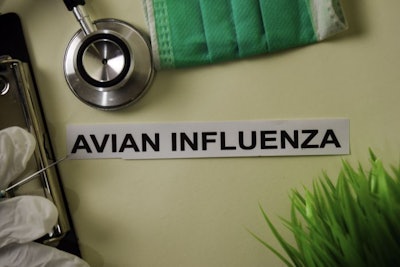
During the latter part of December, seven Asian countries have registered new outbreaks of highly pathogenic avian influenza (HPAI) in poultry. Not only are outbreaks occurring widely across the continent from the Middle East to the Pacific, at least three different virus serotypes are involved. China has reported a further eight new lab-confirmed cases of avian-origin influenza in human patients.
Avian influenza in Israeli poultry
Since the start of December, the animal health agency in Israel has officially registered six new HPAI outbreaks in poultry.
According to the latest reports to the report to the World Organisation for Animal Health (OIE), affected were a total of more than 620,000 birds, all on commercial farms.
In early December, the H5N1 virus serotype was detected in 13-week-old turkeys in the Southern District (Hadarom). Over the following week, a similar flock of around 17,000 birds in Golan as well as 244,000 laying hens in the Northern District (Hazafon) tested positive for the virus. Most recently, the virus has been detected in three more commercial meat turkey flocks – one in each of Golan, the Northern District, and the Central District (Hamerkaz).
In October, Israel registered its first cases of poultry positive for the H5N1 virus variant since 2015. Since then, 10 poultry flocks comprising a total of more than 707,000 birds have tested positive for this HPAI serotype.
Israel: Concern over possible virus transmission to humans
Over recent weeks, Israel’s veterinary authority has also confirmed to the OIE detection of the H5N1 HPAI virus in wild birds.
Among the birds affected was mass mortality of 5,000 wild cranes in the Hula valley in the Northern District, reported Times of Israel.
Expressing concerns about the possible future spread of the disease to people is one of the country’s leading epidemiologists. Meanwhile, an environmental expert raised the prospect of viral spread through water to the Sea of Galilee. However, transmission of the virus in water has so far never been documented.
Recent deaths of the wild cranes and a preemptive cull of more than half a million chickens have been described by Environmental Protection Minister Tamar Zandberg as “the worst blow to wildlife” in the country’s history.
Meanwhile, health experts are trying to allay these fears, reported Haaretz.
Officials say it is “highly unlikely” that the avian flu virus will turn into a human pandemic to rival COVID. Nevertheless, the government and public health agencies are preparing for the theoretical possibility.
Further outbreaks confirmed in South Korea
In South Korea, 14 HPAI outbreaks in poultry linked to the H5N1 HPAI virus serotype so far this winter have been confirmed with the OIE. These have directly impacted more than 1.63 million poultry in the country.
During the second half of December, the most recent cases were detected in two commercial layer flocks — 65,000 birds in South Chungcheong province, and 344,000 in the Sejong city region. These were the first cases so far in Sejong. As a result of surveillance, a flock of 29,000 poultry of unspecified type were also found to be positive for the virus in South Jeolla province.
According to Yonhap news agency, the HPAI virus was subsequently detected among 12,000 ducks at a farm in South Jeolla. The disease is also suspected in another commercial duck flock, this time in the Busan city region in the far south of the country.
Taiwan registers new HPAI H5N2 outbreaks
To the OIE, the veterinary authority of Taiwan has recently reported nine HPAI outbreaks in poultry. At each location, presence of the H5N2 virus serotype has been confirmed.
Directly impacted through mortality or culling to prevent further spread of the infection have been around 66,400 poultry. Among those affected were native chickens at a slaughterhouse in Pingtung county, as well as 50 carcasses discarded in Nantou. The other seven outbreaks were identified at farms in the counties of Yunlin and Changhua in native chickens, meat and breeding geese, laying hens, and turkeys.
According to the official report, genetic sequencing of the virus involved reveals it as a clade 2.3.4.4.b, similar to one detected in a duck carcass in Taiwan in early August of 2021.
Highly pathogenic H5N2 virus was detected in several Taiwanese poultry flocks during 2020.
HPAI viruses detected in Japanese flocks
Number of confirmed outbreaks of HPAI in Japan’s poultry flocks so far this winter currently stands at nine, according to the agriculture ministry (as of December 31).
Of these, the H5N1 virus serotype has now been detected at seven locations in the country between November 10 and December 11. These outbreaks have directly involved a total of almost 315,000 poultry.
Latest cases have affected three commercial flocks on the island of Honshu, according to recent reports to the OIE. These include 30,000 laying hens in Hiroshima prefecture, 17,000 more in Saitama, and 7,000 broiler breeders in Aomori.
In November, the H5N8 HPAI virus was detected in two more Japanese poultry flocks comprising a total of 154,000 birds. No further cases have been detected since the middle of that month, and the two outbreaks have been declared “ended,” according to the latest official report to the OIE. Movement restrictions have been lifted at both locations — one in northern Honshu and one on the southwestern island of Kyushu.
Avian flu reemerges in South Asian poultry
During the third week of November, poultry at four locations in Pakistan’s North West Frontier province tested positive for an HPAI virus of the H5 family. These were the first such cases since August of 2021, according to the OIE report. Affected were two farms and two backyard flocks, each comprising between 200 and 3,000 poultry.
At around the same time, first cases of H5N1 HPAI were detected in the southern Indian state of Kerala. Out of a village flock of almost 19,000 ducks, 9,750 died. This was the state’s first outbreak since September of 2020.
Previously in November, first wild birds tested positive for the same virus serotype in the northwestern state of Rajasthan. During the same month, the H5N8 virus was detected in Madhya Pradesh in central India.
First HPAI outbreak on Iranian farm
In mid-December, HPAI virus of the H5N5 serotype was detected on a poultry farm and in a village flock in Iran. This was the first outbreak to affect a commercial flock in the country in the present disease wave, based on reports to the OIE.
Affected were 34,600 broiler breeders, and a mixed flock in the same district in the northwestern province of Gilan.
Since October of 2021, this virus variant had previously been detected in four village flocks. All were in the north of the country, but in other provinces.
Latest cases bring the total outbreaks linked to this virus in the Islamic Republic of Iran over the past three months to six. Directly affected have been around 37,350 poultry, including 1,500 mortalities.
Situation “resolved” in Laos, Russian Urals region
According to a recent notification to the OIE, the veterinary authority of Laos considers the HPAI situation “closed.”
At the end of August, a single outbreak linked to a virus of the H5 family was identified in an isolated backyard poultry flock in the east of the country. All 415 of the birds died, but no further cases have been identified in the meantime.
In the Russian Urals federal district region of Chelyabinsk, two HPAI outbreaks in poultry were confirmed in late August and early September. Affected were a total of around 18,200 poultry in one commercial and one backyard flock. As no further cases with the H5N1 virus variant have been detected in this region, the Russian authorities report the outbreak ended on December 3.
Wild birds test positive for H5N1 in four Asian territories
In addition to the cases in Israel, wild birds have tested positive for the H5N1 HPAI virus in Hong Kong, South Korea, and Taiwan during the month of December. Cases were reported to the OIE by the respective veterinary agencies.
For Hong Kong, the one bird represented the first case since January of 2021. However, the two cases in Taiwan were the first in the territory ever to test positive for this serotype of the virus. In South Korea, a further nine wild birds have tested positive for the H5N1 HPAI virus. Based on information supplied to the OIE, these bring to 14 the number of cases in wild birds in the country since October.
In a separate report to the OIE, Taiwan’s authorities have declared the situation regarding the H5N2 HPAI virus in wild birds to be “resolved.” This followed a single positive case in a wild duck in early August of 2021. As reported above, this virus variant now appears to be circulating in the territory’s domestic poultry.
China records new human infections with flu of avian origin
Over the period December 3-23, the World Health Organization (WHO) was informed by the authorities in China about six cases of avian influenza A(H5N6) in human patients.
All had previous contact with sick or dead poultry, and no cases were detected among their contacts. Three of these cases were in Hunan province, and one each in Sichuan, Guangdong, and Guangxi. One of the patients was a three-year-old boy. However, the others were adults aged between 49 and 72 years — similar in age to the great majority of earlier cases in China.
These latest cases bring to 58 the number of lab-confirmed cases linked to this virus serotype reported to the WHO in the Western Pacific region since 2014. Of this total, 27 of the patients have died, including one of the new cases.
Furthermore, WHO has also been notified by the China’s health authority about two new cases of human infection linked to a different influenza A virus of avian origin — the H9N2 variant. Affected were two seven-year-olds — one girl and one boy — in different cities in Guangdong province. Both were reported to have developed mild symptoms following previous contact with sick poultry.
To date, 20 cases of avian influenza A(H9N2) in China have been reported to WHO in 2021. Since 2015, WHO has been notified of a total of 61 cases of human infection with this virus serotype (including two deaths) in the Western Pacific.
View our continuing coverage of the global avian influenza situation.

















